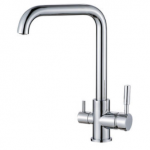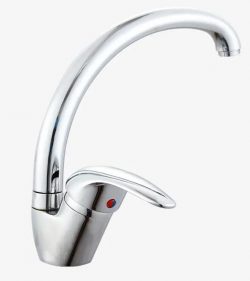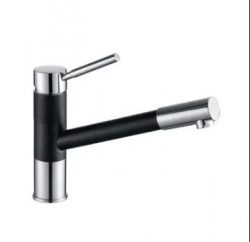How to Clean and Maintain Your kitchen faucet
There are some safety concerns associated with using a kitchen faucet, especially if it is not maintained properly or used incorrectly. Here are some safety concerns to be aware of:Cross-contamination: Cross-contamination can occur if the faucet is not cleaned properly. Bacteria and other microorganisms can accumulate in the faucet and be transferred to food or other surfaces. To prevent cross-contamination, clean the faucet regularly with soap and water.Slips and falls: Water splashing around the kitchen sink can create slippery surfaces, increasing the risk of slips and falls. Clean up any water spills promptly and use non-slip mats or rugs near the sink area to provide traction.Proper handling of sharp objects: When using the kitchen faucet for tasks like washing knives or other sharp objects, exercise caution to prevent accidental cuts or injuries. Avoid placing your hands or fingers in the direct path of the water flow to reduce the risk of accidental contact with sharp edges.Water pressure: High water pressure from the kitchen faucet can lead to splashing, causing water to spray onto nearby electrical outlets or appliances. Be mindful of the water pressure settings, and adjust them as needed to prevent water from reaching electrical components.Proper installation and maintenance: Ensure that your kitchen faucet is installed correctly by a professional or following the manufacturer’s instructions. Regularly check for any leaks, loose connections, or other signs of damage. Promptly address any maintenance or repair needs to prevent potential hazards.Cleaning and maintaining your kitchen faucet is important to keep it looking and functioning like new. Here are some tips and tricks for cleaning and maintaining your kitchen faucet:Clean the faucet regularly: Use a soft cloth and mild soap to clean your kitchen faucet regularly. Avoid using harsh chemicals or abrasive scrubbers that can damage the finish. Be sure to dry the faucet after cleaning to prevent water spots.Use the right water pressure: Make sure you’re using the right water pressure for the task at hand. For example, when washing delicate items, use a low-pressure stream to avoid damaging them, and when washing dishes or filling pots, use a higher-pressure stream for efficiency.Check the water supply valves: Check the water supply valves under the sink to make sure they are fully open. If they are not, the faucet may not get enough water pressure to function properly.Fix leaks promptly: If you notice any leaks in your kitchen faucet, fix them promptly. Even a small leak can waste a significant amount of water over time, driving up your water bill and potentially causing water damage.Prevent lime scale buildup: If you live in an area with hard water, lime scale buildup can be a common problem. To prevent it, wipe your faucet dry after each use, or use a soft cloth soaked in vinegar to remove any mineral deposits. Additionally, consider installing a water softener or a lime scale filter if the problem persists.Check for leaks: Regularly inspect your faucet for any signs of leaks. A leaking faucet not only wastes water but can also lead to other issues. If you notice a leak, address it promptly by replacing worn-out washers or calling a plumber for assistance.By being aware of these safety concerns and following the Custom Kitchen faucet factory instructions for installation and maintenance, you can use your kitchen faucet safely and prevent accidents and injuries. If you have any questions or concerns about the safety of your kitchen faucet, consult a professional plumber or the manufacturer for guidance.





